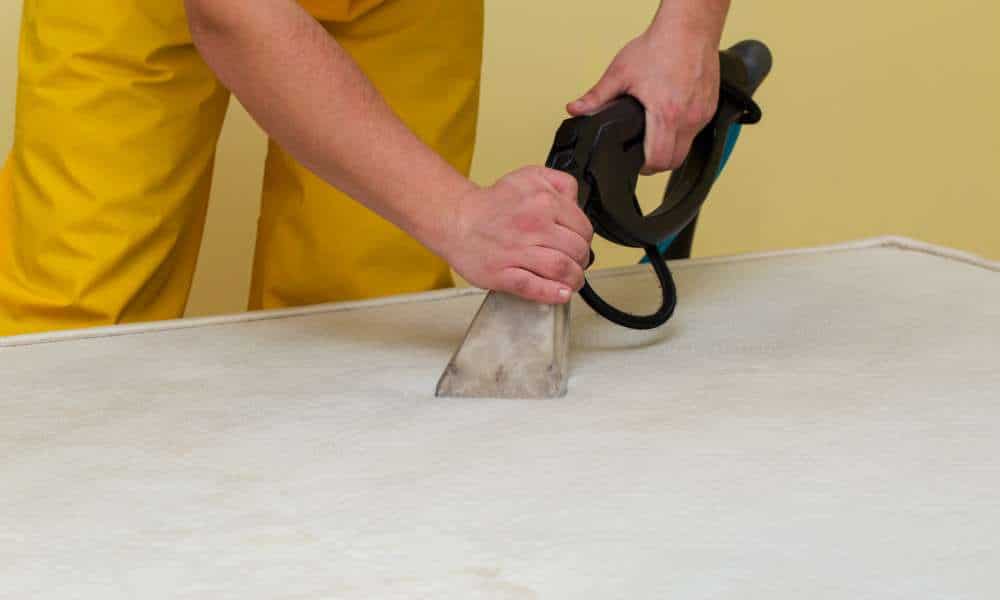Clean a mattress is an essential aspect of maintaining a hygienic sleeping environment, yet it often goes overlooked. This task, crucial for ensuring a good night’s sleep, involves more than just changing the sheets and fluffing pillows. From removing dust mites and allergens to addressing stains and odors, a thorough mattress cleaning can rejuvenate your sleeping space and extend the life of your bed. With the right approach and some simple tools, you can transform your bed into a fresh, clean haven for rest and relaxation.
Best Time to Clean a Mattress
The best time to clean mattresses is during a period of low humidity and ample ventilation, ideally in the spring or early fall. These seasons offer the perfect conditions for the mattresses to dry thoroughly after cleaning, preventing moisture from becoming trapped inside, which could lead to mold or mildew growth. Additionally, incorporating bed cleaning into your seasonal deep-clean routines ensures that it doesn’t become an overlooked task. Aim to clean your mattresses at least twice a year to maintain its freshness and extend its lifespan. Taking advantage of these optimal times for clean will not only make the process more efficient but also more effective in maintaining a hygienic sleeping environment.
Importance of Cleaning a Mattress
Cleaning a mattress is crucial for several reasons beyond just maintaining its appearance. Firstly, regular cleaning helps to eliminate allergens such as dust mites, pet dander, and pollen, which can accumulate over time and exacerbate allergies and respiratory issues. Additionally, it helps to remove bodily fluids, skin flakes, and oils that can attract dust mites and other pests. Clean your bed also extends its life by preventing the buildup of contaminants that can degrade its materials. Moreover, a clean mattress contributes to a healthier sleeping environment, promoting better sleep quality and overall well-being. Ignoring mattresses’ cleanliness can lead to a range of problems from unpleasant odors to increased health risks, underscoring the importance of regular cleaning.
Basic Mattress Cleaning Steps
1. Vacuuming the Mattress
The first step in cleaning your mattresses is to vacuum it thoroughly. This process removes dust, dead skin cells, dust mites, and other allergens that accumulate on the surface over time. Use the upholstery attachment on your vacuum cleaner to ensure a gentle yet effective clean. Start from the top of the bed and work your way down in overlapping, narrow paths. Don’t forget to vacuum the sides and the box spring if you have one. Regular vacuuming, ideally every two to three months, can significantly reduce the amount of allergenic material on your bed and maintain its cleanliness.
2. Spot Cleaning Stains
After vacuuming, the next step is to tackle any stains on the mattress. It’s important to address spills and stains promptly to prevent them from setting in. Use a mild detergent solution or a specialized stain remover suitable for mattresses. Apply the cleaning solution to a clean cloth and gently dab at the stain, avoiding soaking the mattresses. For protein-based stains such as blood or sweat, using an enzyme cleaner can be particularly effective. Remember to always test any clean solution on a small, inconspicuous area of the mattress first to ensure it does not cause damage or discoloration.
3. Deodorizing
The final step is to deodorize the mattresses, removing any lingering odors and freshening up the sleeping surface. Baking soda is an excellent natural deodorizer for this purpose. Sprinkle a generous amount of baking soda over the entire surface of the mattresses, and let it sit for several hours or even overnight if possible. The baking soda will absorb any odors, leaving your bed smelling fresh. After the baking soda has had time to work, vacuum the mattress again to remove the powder. This step not only deodorizes but also contributes to the overall cleanliness of your bed.
Deep Cleaning Your Mattress
1. Removing Tough Stains
For tough stains that spot cleaning can’t remove, consider using a more potent stain remover or a mixture of natural ingredients. One effective solution is a mixture of hydrogen peroxide, liquid dish soap, and baking soda. Apply this mixture directly to the stain and let it bubble for a few minutes before gently dabbing it away with a clean cloth. For organic stains, such as urine or blood, an enzyme-based cleaner can be particularly effective, breaking down the proteins in the stain without damaging the mattress material. Always use the minimum amount of liquid necessary to reduce the risk of water damage to your bed.
2. Steam Cleaning
Steam cleaning is a powerful method for deep cleaning your mattress. It not only removes stains and dirt but also kills bacteria, dust mites, and other allergens without the use of harsh chemicals. However, steam clean should be done cautiously, as too much moisture can be harmful. Use a handheld steam cleaner and maintain a safe distance to prevent saturating the mattress. Move the steamer slowly across the surface, allowing the steam to penetrate and clean without wetting the bed excessively.
3. Drying and Airing Out
After deep cleaning, thoroughly drying and airing out your mattress is crucial to prevent mold and mildew growth. If possible, move the bed to a well-ventilated area or outside in the sun, which has natural sanitizing properties. If outdoor drying isn’t an option, use fans to circulate air around the mattress or a dehumidifier to help remove moisture. Ensure the bed is completely dry before putting sheets back on. This might take several hours or even a full day, depending on the humidity and ventilation in your space.
When to Use Chemical Cleaners
Chemical cleaners should be considered for mattress cleaning when natural solutions are insufficient for removing tough stains or disinfecting. They can be particularly effective against persistent stains, such as ink, grease, or certain food spills, that household remedies cannot tackle. Additionally, if your bed has been exposed to pathogens or allergens that require thorough eradication, specific chemical disinfectants can ensure a hygienic sleeping environment. However, it’s important to use these cleaners judiciously. Always opt for products that are safe for use on mattresses and follow the manufacturer’s instructions closely to avoid damaging the mattress materials. Ensure adequate ventilation when using chemical cleaners to minimize inhalation of fumes. Lastly, consider the environmental impact and personal health sensitivities when choosing chemical cleaners, opting for those with less harmful ingredients whenever possible.
Read More: Best Mattress Use
Conclusion
Maintaining a clean mattress is essential for a healthy, comfortable sleep environment. From regular vacuuming and spot cleaning to the occasional deep clean, each step plays a crucial role in extending the life of your mattresses and ensuring it remains a safe, pleasant place to rest. While natural cleaning methods are often sufficient and preferable for their safety and environmental benefits, there are circumstances where chemical cleaners may be necessary. Regardless of the methods used, the key is regular maintenance and prompt attention to spills and stains. By incorporating mattresses cleaning into your household cleaning routine, you can enjoy a fresher, more hygienic sleep surface night after night.




